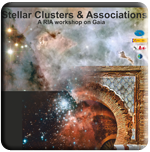Large scale kinematics and dynamical modelling of the Milky Way nuclear star cluster
Feldmeier, A.; Neumayer, N.; Seth, A.; Schödel, R.; Lützgendorf, N.; de Zeeuw, P. T.; Kissler-Patig, M.; Nishiyama, S.; Walcher, C. J.
Astronomy & Astrophysics, Volume 570, id.A2, 20 pp. (2014).
10/2014
ABSTRACT
Context. Within the central 10 pc of our Galaxy lies a dense cluster of stars. This nuclear star cluster forms a distinct component of the Galaxy, and similar nuclear star clusters are found in most nearby spiral and elliptical galaxies. Studying the structure and kinematics of nuclear star clusters reveals the history of mass accretion and growth of galaxy nuclei and central massive black holes.
Aims: Because the Milky Way nuclear star cluster is at a distance of only 8 kpc, we can spatially resolve the cluster on sub-parsec scales. This makes the Milky Way nuclear star cluster a reference object for understanding the formation of all nuclear star clusters.
Methods: We have used the near-infrared long-slit spectrograph ISAAC (VLT) in a drift-scan to construct an integral-field spectroscopic map of the central ˜9.5 × 8 pc of our Galaxy, and six smaller fields out to 19 pc along the Galactic plane. We use this spectroscopic data set to extract stellar kinematics both of individual stars and from the unresolved integrated light spectrum. We present a velocity and dispersion map from the integrated light spectra and model these kinematics using kinemetry and axisymmetric Jeans models. We also measure radial velocities and CO bandhead strengths of 1375 spectra from individual stars.
Results: We find kinematic complexity in the nuclear star clusters radial velocity map including a misalignment of the kinematic position angle by 9◦ counterclockwise relative to the Galactic plane, and indications for a rotating substructure perpendicular to the Galactic plane at a radius of 20'' or ˜0.8 pc. We determine the mass of the nuclear star cluster within r = 4.2 pc to (1.4+0.6-0.7) × 107 M⊙. We also show that our kinematic data results in a significant underestimation of the supermassive black hole (SMBH) mass.
Conclusions: The kinematic substructure and position angle misalignment may hint at distinct accretion events. This indicates that the Milky Way nuclear star cluster grew at least partly by the mergers of massive star clusters. Compared to other nuclear star clusters, the Milky Way nuclear star cluster is on the compact side of the reff - MNSC relation. The underestimation of the SMBH mass might be caused by the kinematic misalignment and a stellar population gradient. But it is also possible that there is a bias in SMBH mass measurements obtained with integrated light, and this might affect SMBH mass determinations of other galaxies.
Based on observations collected at the European Organisation for Astronomical Research in the Southern Hemisphere, Chile (289.B-5010(A)).Appendices are available in electronic form at http://www.aanda.orgSpectra and data cubes are only available at the CDS via anonymous ftp to http://cdsarc.u-strasbg.fr (ftp://130.79.128.5) or via http://cdsarc.u-strasbg.fr/viz-bin/qcat?J/A+A/570/A2


